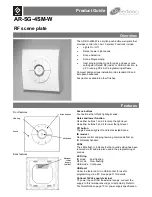
MS51
Nov. 28, 2019
Page
363
of 491
Rev 1.00
MS51
32K
SE
RIES
TE
CHNICAL RE
F
EREN
CE MA
N
UAL
6.9 Serial Port (UART0 & UART1)
6.9.1
Overview
The MS51 includes two enhanced full duplex serial ports enhanced with automatic address
recognition and framing error detection. As control bits of these two serial ports are implemented the
same. Generally speaking, in the following contents, there will not be any reference to serial port 1, but
only to serial port 0.
Each serial port supports one synchronous communication mode, Mode 0, and three modes of full
duplex UART (Universal Asynchronous Receiver and Transmitter), Mode 1, 2, and 3. This means it
can transmit and receive simultaneously. The serial port is also receiving-buffered, meaning it can
commence reception of a second byte before a previously received byte has been read from the
register. The receiving and transmitting registers are both accessed at SBUF. Writing to SBUF loads
the transmitting register, and reading SBUF accesses a physically separate receiving register. There
are four operation modes in serial port. In all four modes, transmission initiates by any instruction that
uses SBUF as a destination register.
6.9.2
Operating Modes
Mode 0
6.9.2.1
Mode 0 provides synchronous communication with external devices. Serial data centers and exits
through RXD pin. TXD outputs the shift clocks. 8-bit frame of data are transmitted or received. Mode 0
therefore provides half-duplex communication because the transmitting or receiving data is via the
same data line RXD. The baud rate is enhanced to be selected as F
SYS
/12 if SM2 (SCON.5) is 0 or as
F
SYS
/2 if SM2 is 1. Note that whenever transmitting or receiving, the serial clock is always generated
by the MCU. Thus any device on the serial port in Mode 0 should accept the MCU as the master.
Figure 6.9-1 shows the associated timing of the serial port in Mode 0.
Figure 6.9-1 Serial Port Mode 0 Timing Diagram
As shown there is one bi-directional data line (RXD) and one shift clock line (TXD). The shift clocks
are used to shift data in or out of the serial port controller bit by bit for a serial communication. Data
bits enter or emit LSB first. The band rate is equal to the shift clock frequency.
Transmission is initiated by any instruction writes to SBUF. The control block will then shift out the
clocks and begin to transfer data until all 8 bits are complete. Then the transmitted flag TI (SCON.1)
will be set 1 to indicate one byte transmitting complete.
Reception is initiated by the condition REN (SCON.4) = 1 and RI (SCON.0) = 0. This condition tells the
serial port controller that there is data to be shifted in. This process will continue until 8 bits have been
















































